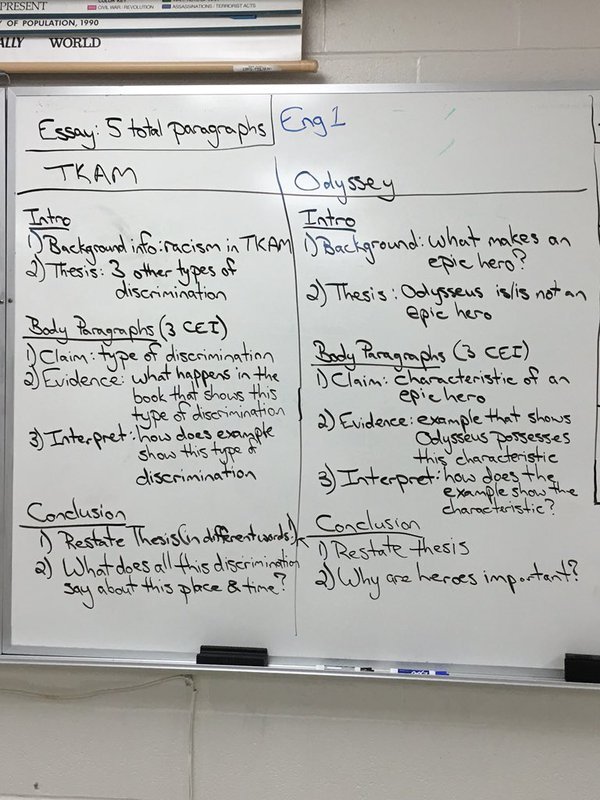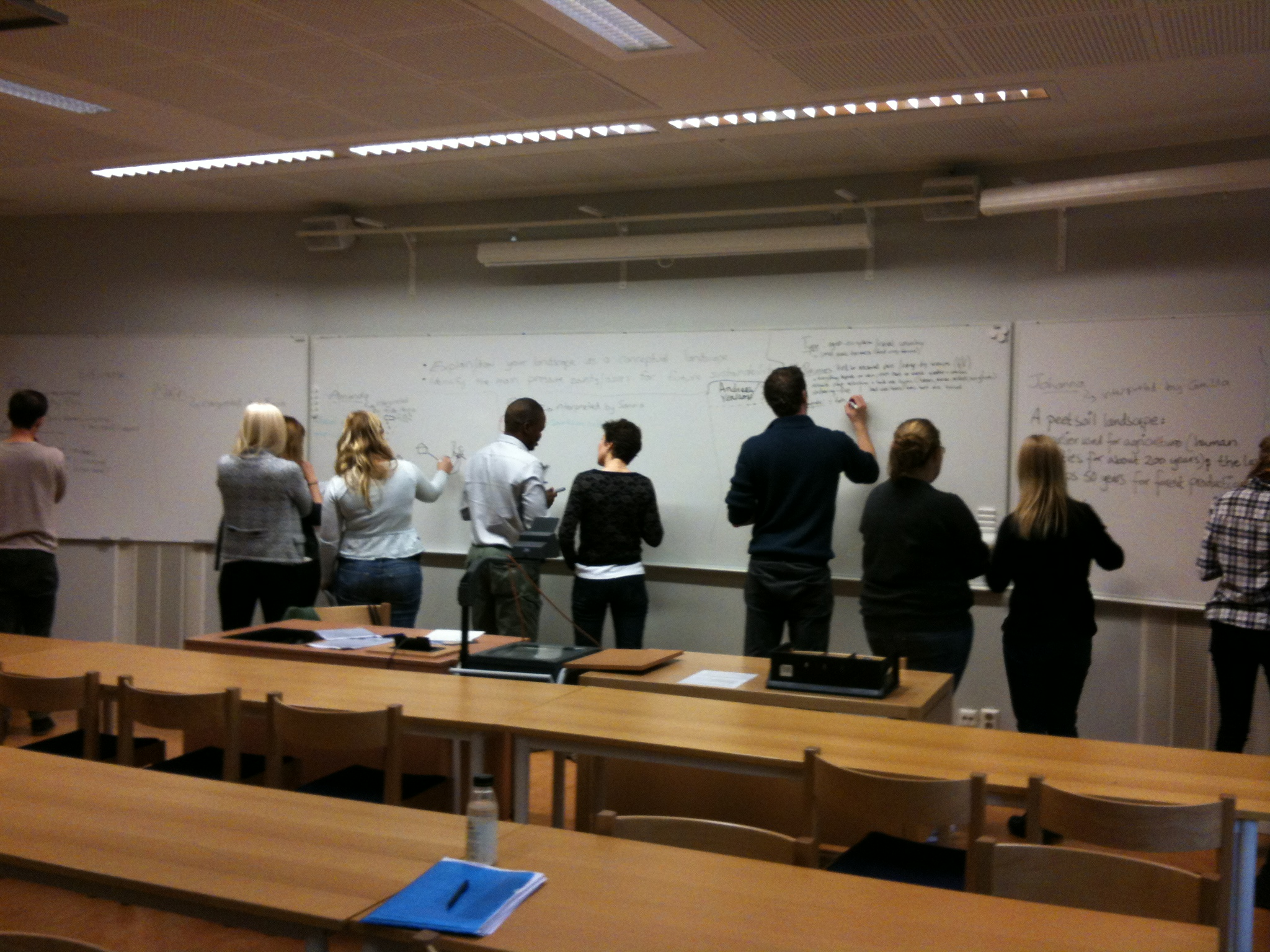Write on the Whiteboard Every Class: My Advice to Teachers Straight out of Undergrad
An Old School Answer to an Common Problem
If I were speaking to 22-year-old, recently graduated, aspiring teachers I would give them one piece of advice:
Find a way to write on the white board every single class.
This is the one thing I've found that can wake up a sleepy class. I’ve taught freshman composition for 5 years now at the community college level. Like every teacher I must consider the following questions on a daily basis: (1) “How do I get my students to retain key information?” and (2) “How do I get my students to pay attention for long periods of time?”
Teachers, whether they are teaching pre-school kids or seniors at a university, will quickly understand the need to consider these two questions before every class. Since Millennials (and many people in older generations) are considered to be people who “cannot pay attention” and are fatally distracted, these issues become more urgent and teachers become desperate to solve them. To be a teacher today is to possess a variety of strategies to engage those doomed students with ADHD symptoms. But what is an effective strategy? How do you keep your composition students to keep their eyes on you?
The common solution that I've heard for years is that to reach younger and future generations is to find any way to integrate technology into your daily curriculum. Sometimes this means finding educational apps online that allow students text in their answers. Some high schools, community colleges and universities have invested thousands of dollars into Smartboards and new computers with the hope of becoming relevant to students. Teachers are desperate to connect-----and technology in the classroom is often seen as the magic bullet.
I’m a 33-year-old Millennial and I believe investing more time and money into “technology in the classroom” is a flawed shortcut to these challenges-----not a long-term solution. Most Millennials are bombarded all kinds of technological gimmicks geared to "connect" with them through advertisement before a Youtube video or getting them to follow an Instagram brand. Could it be that students will check out even more if teachers are trying the same gimmick-like methods? I have a skepticism of these new “methods,” so I assume my students will likely have a similar skepticism. Could it be that the brand-new Millennial teachers need to be searching for old-school methods with connecting with students?
My suggestion to connect with students is to write on the whiteboard every single class.
Here are a five reasons why the whiteboard has consistently helped me gain my students attention:
1. Writing on the whiteboard is spontaneous.
I typically draw on the whiteboard whenever students ask a question or look confused. I break out of my lecture for the class and try to draw something to help answer the student’s question. I find that sometimes when I break out of my lecture and explain a concept without notes, it comes off much more naturally. I typically map out an outline of an essay, which does wonders to draw the eyes of the students to the front of the room.
There is a specific facial expression students make when they are paying attention. They look at me and do not look away. As if I were a comedian about to tell the punchline of a joke. This sounds like common sense, but if they are staring at the wall, the back of the person’s head in front of them or sneaking a peek at their phone, they are not fully engaged. When I do break away from my PowerPoint to draw an outline of an essay on the whiteboard, it has an element of surprise.
If I’ve given the same lecture many times, my lecture or PowerPoint presentation can come out a little bit stale. Spontaneously drawing on the board seems to prove that whatever you are teaching is coming from your long-term memory. It shows that whatever you are spouting off is not being read off a teleprompter. You actually know the information and sometimes forces me to explain it impromptu, which makes my presentation more believable.
2. Writing on the whiteboard is sloppy.
In contrast to a perfectly crafted PowerPoint presentation or a Youtube video (with 2 million hits) that has been crafted perfectly, the whiteboard allows for me to throw out a “live rough draft” on the board. Writing is a process and a sloppy outline of an essay can be encouraging to the students.
When I teach the argumentative thesis statement, students like to see an outline on the board as I am thinking it. It is thinking in real time. So they can see how I am plugging in certain ideas for paragraphs. (Possible example after this) I remember one of my English teachers in community college jotting down an outline on the back of a scarp piece of paper for my English essay. The sort of ease that she wrote it down made me believe “Oh, it is that easy? All you have to do is fill in a blank template?”

I must point out that I have never been an artistic person. Because of this, this makes my use of the white board entertaining to students. Since they see that I cannot draw and I have sloppy handwriting, this makes the whole process entertaining.
I am not suggesting that an excellent PowerPoint that is not effective. I use 5-6 slide PowerPoints probably 80 percent of my classes to explain myself. But as the saying goes, “death by PowerPoint” is real and getting an Expo marker and drawing something out is prevents this from happening.
3. Writing on the whiteboard gives students a chance to see their ideas written out.
This past semester I asked my students to define the word “cool” in a class discussion. They started listing off characteristics and phrases. I would write whatever the said on the white board. Students love to see their answers from a discussion written out on the board. It gives them a kind of affirmation.
I saw my favorite professor from UNCW do this on the first day of British literature in the Spring of 2004. After quickly covering the syllabus, Dr. Noland then asked the class what questions they had about the world. He stood at the front of the class with his marker waiting. No one said anything for about a minute. He said it again: “What questions do you have about the world?”
One student timidly said “Where is God?” Dr. Noland excitedly wrote on the board “Where is God?” in big green letters. Another student then spoke up and said “Who is God?” He wrote this on the board. He always passionately wrote answers on the board that made you stay locked into what he was talking about. He did this until he had about 6-7 questions written out.
He was trying to identify questions we wanted to know the answer to, so we would take ownership in the class discussion. Writing the questions out on the board showed us that we did have questions worth pursuing and also it showed us that he was listening to us. The way Dr. Noland used the white-board is one of the reasons his classes were unforgettable.
4. Outlines and visuals on a whiteboard can be erased. They are a one-time experience.
Everything today is replicable. “Can you forward me that email?” “Can you print me off a copy of that?” “Can you take a picture of that and text it to me?” When student see that you are going to erase their ideas on the white-board, they get their phones out and start taking pictures of it. The idea that it will be erased and forgotten makes the experience unique and they realize “Oh wait. This won't be here tomorrow.”
One of my professors drew a picture of Henry David Thoreau sitting in an osprey nest in the middle of class. He did it on a dry-erase board. It took him at least 15-20 minutes to draw it, but his goal was to get the point across about how Thoreau had really influenced the genre of nature writing. Below Thoreau he drew a chart of the authors that Thoreau directly and indirectly influenced in style and content. He had fun while drawing this and the class enjoyed it. I will always remember the fact that Thoreau influenced Edward Abbey and Annie Dillard because of what David Gessner drew on the board that day. There is no chart on Google images or in a textbook of Thoreau’s sphere of influence (at least like Gessner’s drawing) because he drew it on the board.
To this day, I remember Gessner’s drawing and the fact that Thoreau climbed into an osprey nest.
5. Concepts can become easier to understand if they are written out visually to see. And also when we have to draw them out-ourselves on paper/whiteboard.
My friend Sean, who is in medical school to be a surgeon, says he has a motto about learning: “See it once, do it once, teach it once.” His dad, who is also a doctor, told him this when he was young. When we experience a concept(or task) in different ways, we are more likely to understand that particular concept(or task). Whether that is an abstract concept about the nature of history or if that is understanding how to change a flat tire, it is helps to experience the thing you want to learn in various ways.
I’ve also found that having my students write out their answers on the whiteboard helps the students retain the information. They must go beyond hearing me talk about it, but also write about it on the white-board. They also have to experience the embarrassment of having poor handwriting, which actually makes the activity fun.
Abstract concepts seem to settle more in your brain when you must draw it out. Typically what I do is have my students read two articles about whether high school sports are helpful or harmful for academics. I ask my students to write out on the board cause and effect and problem-solution relationships in the article. I ask them to do this in groups of 3-4 students so they must work in teams to concisely (2-3 sentences) write out on the board the cause and effect relationships presented in the article. I find that when they write it on the board, it becomes a more lively discussion as if they retain and process the info more thoroughly.

Ken Robinson’s famous TED talk “Do Schools Kill Creativity?” was illustrated onto a digital whiteboard using phrases and pictures. There’s something comforting about having a complex concept written out on a white-board. It simplifies the particular concept and makes it less abstract.
So if you are a new teacher-------consider buying some Expo markers and drawing something out on the board. Some teachers will tell you to use an Iphone app to make class more interactive. I say use a whiteboard to make class interactive and "real."